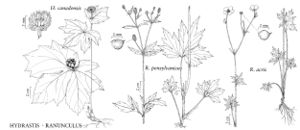Difference between revisions of "Hydrastis canadensis"
Syst. Nat. ed. 10, 2: 1088. 1759.
FNA>Volume Importer |
imported>Volume Importer |
||
| (3 intermediate revisions by 2 users not shown) | |||
| Line 13: | Line 13: | ||
}}{{Treatment/ID/Special_status | }}{{Treatment/ID/Special_status | ||
|code=F | |code=F | ||
| − | |label= | + | |label=Illustrated |
}} | }} | ||
|basionyms= | |basionyms= | ||
| Line 41: | Line 41: | ||
-->{{#Taxon: | -->{{#Taxon: | ||
name=Hydrastis canadensis | name=Hydrastis canadensis | ||
| − | |||
|authority=Linnaeus | |authority=Linnaeus | ||
|rank=species | |rank=species | ||
| Line 55: | Line 54: | ||
|publication title=Syst. Nat. ed. | |publication title=Syst. Nat. ed. | ||
|publication year=1759 | |publication year=1759 | ||
| − | |special status=Endemic; | + | |special status=Endemic;Illustrated |
| − | |source xml=https:// | + | |source xml=https://bitbucket.org/aafc-mbb/fna-data-curation/src/2e0870ddd59836b60bcf96646a41e87ea5a5943a/coarse_grained_fna_xml/V3/V3_979.xml |
|genus=Hydrastis | |genus=Hydrastis | ||
|species=Hydrastis canadensis | |species=Hydrastis canadensis | ||
Latest revision as of 22:52, 5 November 2020
Herbs, 15-50 cm. Rhizomes with tough fibrous roots. Stems erect, unbranched, pubescent. Leaves: basal leaf often quickly deciduous, 1; cauline leaves, 2, similar to basal. Leaf blade 3-10 cm wide at anthesis, to 25 cm wide in fruit; lobes variously incised, margins singly or doubly serrate. Flowers 8-18 mm wide; peduncle 5-38 mm, ± closely subtended by distalmost cauline leaf; sepals not clawed, 3.5-7 mm, glabrous; stamens strongly exserted, white showy, 4-8 mm; pistils 1-carpellate, distinct; stigma 2-lipped. Berry aggregates dark red, 10-15 × 8-15(-20) mm, each berry 5-8 × 1.5-5 mm. Seeds 1-2 per pistil, 2.5-4.5 mm.
Phenology: Flowering spring.
Habitat: Mesic, deciduous forests, often on clay soil
Elevation: 50-1200 m
Distribution

Ont., Ala., Ark., Conn., Del., Ga., Ill., Ind., Iowa, Ky., Md., Mass., Mich., Minn., Miss., Mo., N.J., N.Y., N.C., Ohio, Pa., Tenn., Vt., Va., W.Va., Wis.
Discussion
A decrease in undisturbed, deciduous woodlands and commercial harvesting of the rhizomes for herbal medicine have contributed to a decline of this species. The species is considered very infrequent in Canada (G. W. Argus and K. M. Pryer 1990) and in some U.S. states (D. J. White and H. L. Dickson 1983). The raspberrylike fruit is considered inedible.
Native Americans used Hydrastis canadensis medicinally for treating cancer, whooping cough, diarrhea, liver trouble, earaches, sore eyes, fevers, pneumonia, heart trouble, tuberculosis, chapped or cut lips, and dyspepsy; to improve appetite; and as a tonic, and as a wash for inflammation (D. E. Moerman 1986).
Selected References
None.
